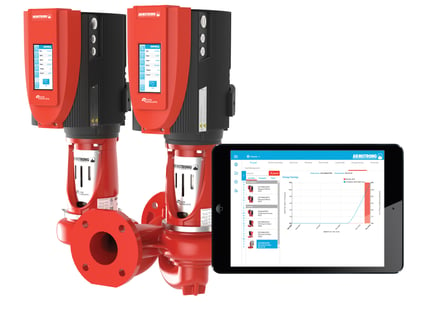As Seen as meuc.co.uk (page no 26): September 2019
 Valuable collection
Valuable collection
Data collection and communication by individual devices is a powerful weapon in the battle for energy efficiency. Energy Upgrade Leader at Armstrong Fluid Technology, Jason Cox, shows how pumps can lead the charge.
Pump technology can play a significant part in industry’s bid to rein in energy use. Through data analytics and automation, pumps can optimise efficiency by reacting swiftly to changes in demand. A vital design consideration that is key in this role is decentralised data collection – the collection of data from energy-using devices
themselves, rather than simply metering energy usage across a site.
The importance of decentralisation was highlighted by MEUC technology consultant, Steve Miller, in his recent article, The Future of the Grid: Part 3 on the MEUC website. The “long-term goal” of decentralisation, Mr Miller said, was “measuring lots of things and then looking for relationships between them.”
Decentralisation has been revolutionised in recent years by the availability of performance-management software. This has been incorporated into the design of the latest generation of heating, ventilation and air conditioning (HVAC) pumps.
These technologies have only recently been introduced to the market. Examples include Armstrong Active Performance Management Suite in which Armstrong’s Pump Manager application outstrips energy saving through flow metering. It achieves this by delivering accurate data collection and performance optimisation throughout the pump’s life.
Online trending and analysis of multiple parameters on single pumps, or on an aggregated basis for multiple pumps, helps to identify degrading performance. That enables users to take a predictive and proactive approach to maintenance. It is used typically by our customers, after installation of new or upgraded HVAC systems, to provide real-time insights and alerts. Identifying in this way, signs of reduced equipment performance long before they create significant problems, enables the user to minimise losses of efficiency during the product’s lifecycle. It
also makes it possible to optimise energy consumption automatically, while retaining pumps at commission status.
Simultaneously, the pump’s embedded software collects data including:
- the average flow profile over time;
- the average energy consumption profile;
- current operation conditions relative to design conditions;
- flow and head relationships;
- three-dimensional pump vibration; and
- carbon footprint reporting data.
These decentralised data give a clear picture of the performance of key energy-consuming pieces of HVAC equipment, in addition to the system as a whole.
Interoperability – also featured in Mr Miller’s article – becomes a possibility when harnessing this technology. He summarised it and its value as: “Lots of systems that play nicely together are far more valuable to you
than lots of systems that don’t. They’re also less work to maintain.”
The software resident in Armstrong Design Envelope models, for example, enables the user to gain a deep understanding of energy consumption, by providing a fully reactive and integrated vision of a building. This can be
integrated with BMA, EMS and CMSS, as well as offering API-APP integration.
Pump Manager is a cloud-based application, enabling data to be stored and manipulated more easily across complex systems.
Start earlier
The intelligence built into the pump can provide a way of saving energy while future energy upgrades are under discussion.
It typically takes a year and a half to reach the implementation stage of a capital expenditure project with the first six months spent collecting data. Data analysis takes up months six to nine then technology solutions and a business plan are developed in months nine to 12. Over the next six months, stakeholders make decisions until the project is finally implemented. During that time, with traditional approaches, not a single kilowatt hour is saved.
A more effective solution is to move forward with the pump replacement aspect of the project (a relatively minor part of the overall capital expenditure) in months one to six. The advanced performance management software
within the pumps then make it possible to reduce energy consumption from the outset. At the same time the pump’s built-in technology collects data that can be used in conjunction with system temperatures to generate a systemspecific load profile. And it can harvest much of the data traditionally acquired through the data acquisition phase of the upgrade process. During months six to nine this information can be used to identify opportunities for system optimisation with high cost/benefit ratios.
The building and load-specific information obtained through the pumps assists product selection and system design for the upgrade project. Meanwhile actual, measurable energy savings can be demonstrated throughout
this process to provide a more persuasive business case for stakeholders. Breaking the project down into smaller sub-projects improves cash flow and the business case begins to write itself.
In his article, Mr Miller said of the entire smart energy approach: “Think of all this as an organism. The more adaptive it is to changing environments, the better able it is to thrive in them”. At Armstrong Fluid Technology, we couldn’t agree more. With today’s pump technology, it is not only feasible, but real and demonstrably beneficial, to think about data collection in this way.
Also seen In:



